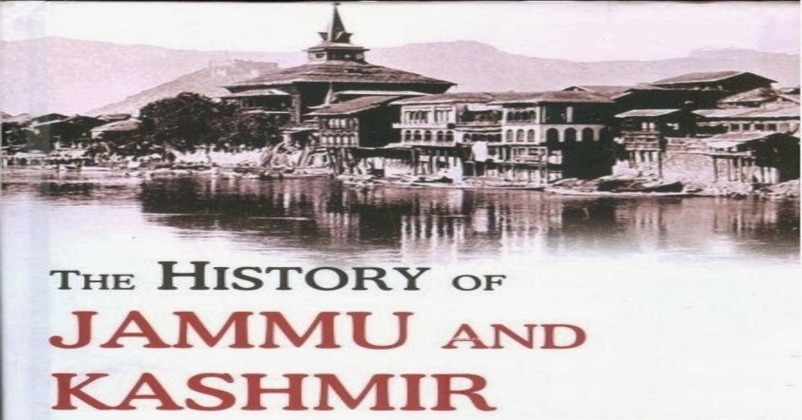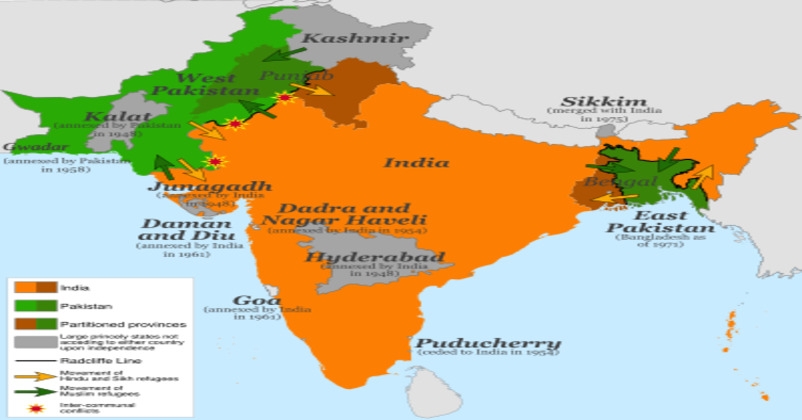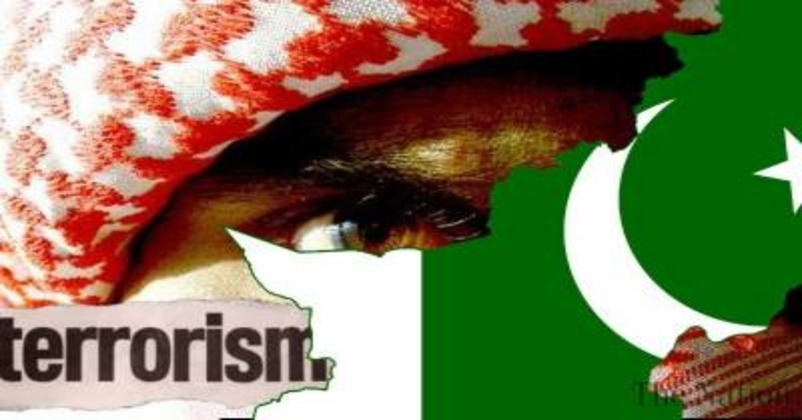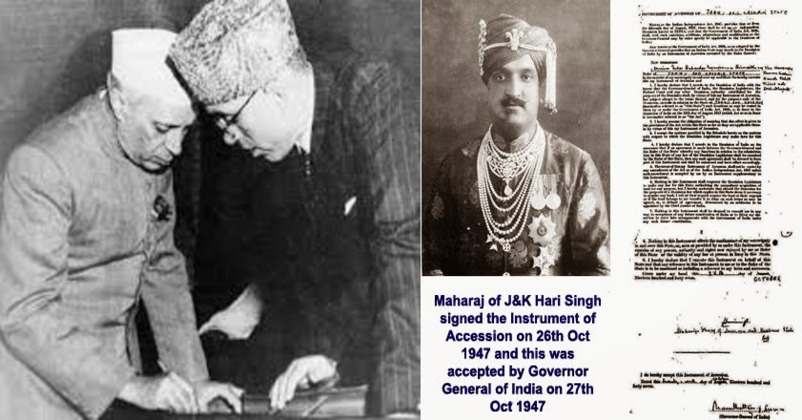Jammu and Kashmir is the 15th state of India and it acceded to India in 1947. It was one of the five Princely states of the British Indian Empire that was directly handled by the Governor General of India / Viceroy of India before India got independence. British had acknowledged the vitality of the state and accorded a 21 Gun Fire Salute to Maharaja of Jammu and Kashmir {Hari Singh Bahadur} like it was given to the Princes of Mysore, Baroda, Gwalior and Hyderabad. Historically also, Jammu and Kashmir had been identified with Bharat {India} because of the similar cultural traditions, practices and the socio-religious identities. The oneness from Himalayas to Kanya Kumari {even through Sri Lanka and Islands around} cannot be overlooked. Though many have tried hard to create tailored or temporarily alien identities for India yet they failed to become successful in their mischief.
India’s independence and carving out Pakistan from India
It is painful that some people fell into the trap of the British rulers and raised the demand to create a separate country called Pakistan exclusively for Muslims. This country was carved out from India. The new dominion Pakistan was made on the demand of some Muslim leaders. These leaders belong to the same India where the Muslims and the Hindus rose collectively against the tyrant East India Company in 1857. The movement and collective efforts continued till 1942, against the British Crown, but the fissure appeared between the two as a result of the sustained policy of British to divide and rule. Pakistan was born before the eve of India’s independence. But the brotherly abode of both the communities remained and even after 15 August 1947 many Muslims preferred to stay back in India.
Massacre after independence and failure of two nation theory
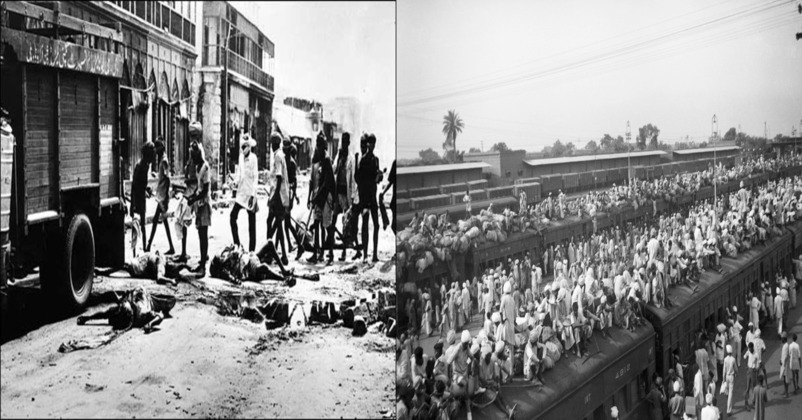
They did not move to “Islamic Republic” of Pakistan {Dominion of Pakistan} that took birth in 1947 and was created exclusively for Muslims. This demonstrates the failure of two nation theory. But both the Hindus and the Muslims paid the price for the misadventure by some of their own people and lakhs of people died and huge number suffered loss of honour/wealth. There are many people in India and Pakistan who curse those people, who were instrumental in severing cultural and traditional ties between the people of the two countries. They curse the people who forced partition of India into two countries in 1947. It was difficult for people of Pakistan to consolidate their identity only on the basis of religion; hence, it broke into two parts in 1971 but the cosmopolitan nature of India accommodated all the people and it still stands united. The foundations rose only on religious considerations collapsed in just two decades and Bangladesh was born. Ironically, the masses in Pakistan and Bangladesh were the worst sufferers of the misadventure of Muslim League.
Pakistan’s support to terrorism
The people of India too have been feeling the heat all these years because of cross border terrorism. Paradoxically, Pakistani governments kept on diverting the attentions of their people from the real issue misgovernance to India. The fact of the matter is that India has as much Muslim population as that of Pakistan. Pakistan makes every effort to entrap the gullible people of Jammu and Kashmir State by presenting falsehoods on religion.
Mishandling of Jammu and Kashmir and myths
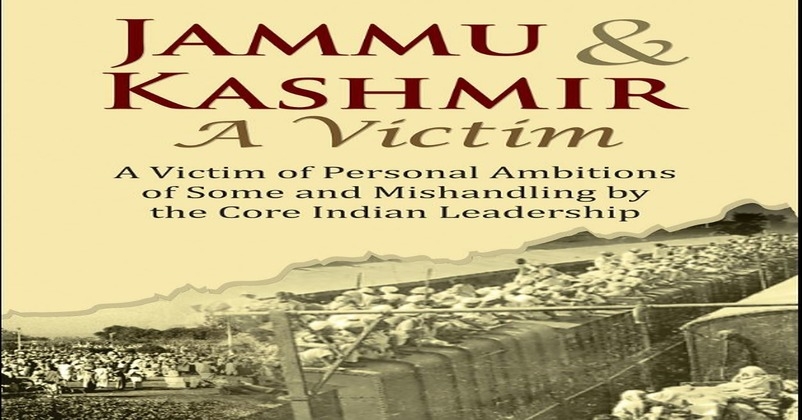
Separatists are present only in five districts of Kashmir valley viz. Srinagar, Baramulla, Anantnag, Shopian, and Pulwama but their views has been spread across India and globe, as if the entire state of Jammu and Kashmir has been confined to these five districts only. The ghost of separatism is getting much attention whereas the real issues of Jammu and Kashmir remain unattended. This clearly reveals the wrong and insincere handling of the JK affairs at the level of Delhi. The misfortune of the people of JK started right after 1946. This mishandling continued and passed from one hand to another. Every successive government was taking less interest in making corrections and their main concern was temporary and cosmetic corrections to the state. This mishandling emboldened separatists and anti accession supporters to spread false propaganda and campaigns. The myth spread by them are {i} 1947 Accession of Kashmir with Indian Dominion was not truthful {ii} 1947 Accession of Kashmir with Indian Dominion was conditional {iii} 1947 Accession of Kashmir with Indian Dominion was not complete. And no doubt where ever possible they used a parameter, which is not found in Jammu and Kashmir, that it was a Muslim majority Princely State. The people of Jammu and Kashmir have remained in confusions and elusions since last 6 decades.
Accession of Jammu and Kashmir was complete and irrevocable
It is beyond doubt that immediately after 1947 Jammu and Kashmir acceded to India and this accession was truthful, final and irrevocable but a small number of people with inclination towards Pakistan making sustained effort to break this beautiful state on the basis of religion. Surprisingly, they had no qualms about how Pakistan butchered their own people in 1947 and later. There are certain facts, which dispel the myth about accession:
- First of all, the Instrument of Accession was a legal instrument used by all the princely states, whether they acceded to India or Pakistan. This instrument was designed after much deliberation by the British and the concurrence for the same was given by the respective rulers of the princely states. This instrument clearly left it to the wisdom of the ruler of the state to accede to either of the dominions. Though certain media houses reported that some people wanted to replace the dynasty rule yet it was the undeniable fact that Maharaja Hari Singh was the recognised and the only legal person to make decision on the matter of accession.
- Secondly, there is no such record of that time, which shows that people were against the decision of the Maharaja. On the contrary, the documents were showing how brutally the administrative structure was crushed by Pakistani mercenaries and people had to run away from their houses for saving their own lives. The affected areas during this bloodbath were Bhimbar, Kotli, Mirpur, Mujjafarabad and Rajouri, where thousands of men, women and children were murdered in a day. Presently, all these areas except Rajouri are under illegal occupation of Pakistan. The documents also speak volumes about how barbarically the males and children were butchered and females were raped during this time. This has made the people of the state to look upto India for help and it was quite obvious that they would stand by the decision of Maharaja.
- Thirdly, the Sheikh Abdullah, himself endorsed the accession of J&K to India, while making the speech at the United Nation Security Council (UNSC) on 5th February, 1948 and in the constituent assembly on 5th November, 1951. In his speech he categorically mentioned why he wishes that the state of J&K shall accede to India and not to the Muslim majority country i.e. Pakistan. He also mentioned that he does not believe in two nation theory or communalism itself. Further, he lamented the massacre of residents of the state. He was even ready to justify the accession of the state to India. In his speech in the UNSC, he categorically mentioned the common wish of Maharaja and the people of the state while acceding to India. He even mentioned that the Prime Minister of India showed his gesture of gratitude when he said ‘India does not want to take advantage of the difficult situation in Kashmir’ and will seek the ratification of people of the state once it is freed from Pakistani invaders.
- Fourthly, the Lord Mountbatten letter of 27th October, 1947 has no legal sanctity as there was no pre-condition in the entire process of accession, which legally binds the ruler, to take people’s wishes into consideration. Further, there was no opposition or protest against the decision of Maharaja. On the contrary people participated in election process of the constituent assembly so that it would prepare the constitution of the state.
- Fifthly, it was not found anywhere in the history that different sorts of instruments, containing specific conditions for any particular princely state(s), were used for accession. So, Maharaja was the only legal person in the matter of accession of J&K to either of the two dominions.
- Sixth, the Indian government went to the UNSC against the Pakistani aggression in J&K and not for any dispute on accession of the state. The same was accepted by the UNSC and it even asked the Pakistan to vacate the piece of land occupied by it illegally though it was a different matter that UNSC did not do anything to ensure the compliance of its decree.
- Seventhly, even Government of India was ready for the plebiscite provided that the two conditions preceding to plebiscite must be fulfilled. These two conditions were ceasefire by Pakistan and withdrawal of Pakistani intruders from the soil of the state so that free and fair elections for the state can be ensured. But the first two conditions never fulfilled and the plebiscite, which was to ensue after the fulfilment of the two conditions, for the entire state never happened. India waited for the international community to intervene in this matter and make a peaceful solution to the problems created by the Pakistani invaders, in this part of the country, but nothing happened in this matter. Therefore, on January 23, 1957 Mr. V. K. Krishna Menon, the Indian representative to UN, made it clear in the United Nation Security Council (UNSC) that J&K including POJK belongs to India only.
- Eighthly, a Constituent Assembly of democratically elected leaders was formed to prepare the Constitution of the state. This Constituent Assembly was created, which has the representation of democratically elected individuals, chosen by the people of the state.
- Finally, the first general elections were held in the state in 1957, after the dissolution of constituent assembly, through well defined procedure for the same and the National Conference emerged as the largest party which formed the government in J&K.
|
